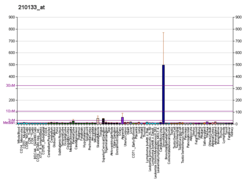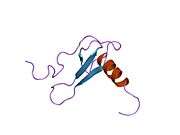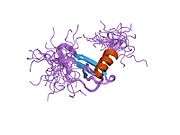CCL11
C-C motif chemokine 11 also known as eosinophil chemotactic protein and eotaxin-1 is a protein that in humans is encoded by the CCL11 gene. This gene is encoded on three exons and is located on chromosome 17.[5][6]
Function
CCL11 is a small cytokine belonging to the CC chemokine family. CCL11 selectively recruits eosinophils by inducing their chemotaxis, and therefore, is implicated in allergic responses.[7][8][9] The effects of CCL11 are mediated by its binding to a G-protein-linked receptor known as a chemokine receptor. Chemokine receptors for which CCL11 is a ligand include CCR2,[10] CCR3[5] and CCR5.[10] However, it has been found that eotaxin-1 (CCL11) has high degree selectivity for its receptor, such that they are inactive on neutrophils and monocytes, which do not express CCR3.[11]
Clinical significance
Increased CCL11 levels in blood plasma are associated with aging in mice and humans.[12] Additionally, it has been demonstrated that exposing young mice to CCL11 or the blood plasma of older mice decreases their neurogenesis and cognitive performance on behavioural tasks thought to be dependent on neurogenesis in the hippocampus.[12]
Higher plasma concentrations of CCL11 have been found in current cannabis users compared to past users and those who had never used. CCL11 has also been found in higher concentrations in people suffering from schizophrenia; cannabis is a known trigger of schizophrenia.[13]
It's also a biomarker for CTE or punch-drunk syndrome.[14]
During periods of bone inflammation, CCL11 and CCR3 are upregulated. This is associated with an increase in osteoclast activity.[15]
References
- GRCh38: Ensembl release 89: ENSG00000172156 - Ensembl, May 2017
- GRCm38: Ensembl release 89: ENSMUSG00000020676 - Ensembl, May 2017
- "Human PubMed Reference:". National Center for Biotechnology Information, U.S. National Library of Medicine.
- "Mouse PubMed Reference:". National Center for Biotechnology Information, U.S. National Library of Medicine.
- Kitaura M, Nakajima T, Imai T, Harada S, Combadiere C, Tiffany HL, Murphy PM, Yoshie O (Mar 1996). "Molecular cloning of human eotaxin, an eosinophil-selective CC chemokine, and identification of a specific eosinophil eotaxin receptor, CC chemokine receptor 3". The Journal of Biological Chemistry. 271 (13): 7725–30. doi:10.1074/jbc.271.13.7725. PMID 8631813.
- Hein H, Schlüter C, Kulke R, Christophers E, Schröder JM, Bartels J (Aug 1997). "Genomic organization, sequence, and transcriptional regulation of the human eotaxin gene". Biochemical and Biophysical Research Communications. 237 (3): 537–42. doi:10.1006/bbrc.1997.7169. PMID 9299399.
- Jose PJ, Griffiths-Johnson DA, Collins PD, Walsh DT, Moqbel R, Totty NF, Truong O, Hsuan JJ, Williams TJ (Mar 1994). "Eotaxin: a potent eosinophil chemoattractant cytokine detected in a guinea pig model of allergic airways inflammation". The Journal of Experimental Medicine. 179 (3): 881–7. doi:10.1084/jem.179.3.881. PMC 2191401. PMID 7509365.
- Ponath PD, Qin S, Ringler DJ, Clark-Lewis I, Wang J, Kassam N, Smith H, Shi X, Gonzalo JA, Newman W, Gutierrez-Ramos JC, Mackay CR (Feb 1996). "Cloning of the human eosinophil chemoattractant, eotaxin. Expression, receptor binding, and functional properties suggest a mechanism for the selective recruitment of eosinophils". The Journal of Clinical Investigation. 97 (3): 604–12. doi:10.1172/JCI118456. PMC 507095. PMID 8609214.
- Garcia-Zepeda EA, Rothenberg ME, Ownbey RT, Celestin J, Leder P, Luster AD (Apr 1996). "Human eotaxin is a specific chemoattractant for eosinophil cells and provides a new mechanism to explain tissue eosinophilia". Nature Medicine. 2 (4): 449–56. doi:10.1038/nm0496-449. PMID 8597956.
- Ogilvie P, Bardi G, Clark-Lewis I, Baggiolini M, Uguccioni M (Apr 2001). "Eotaxin is a natural antagonist for CCR2 and an agonist for CCR5". Blood. 97 (7): 1920–4. doi:10.1182/blood.V97.7.1920. PMID 11264152.
- Baggiolini M, Dewald B, Moser B (1997). "Human chemokines: an update". Annual Review of Immunology. 15: 675–705. doi:10.1146/annurev.immunol.15.1.675. PMID 9143704.
- Villeda SA, Luo J, Mosher KI, Zou B, Britschgi M, Bieri G, et al. (Sep 2011). "The ageing systemic milieu negatively regulates neurogenesis and cognitive function". Nature. 477 (7362): 90–4. doi:10.1038/nature10357. PMC 3170097. PMID 21886162.
- Fernandez-Egea E, Scoriels L, Theegala S, Giro M, Ozanne SE, Burling K, Jones PB (Oct 2013). "Cannabis use is associated with increased CCL11 plasma levels in young healthy volunteers". Progress in Neuro-Psychopharmacology & Biological Psychiatry. 46: 25–8. doi:10.1016/j.pnpbp.2013.06.011. PMID 23820464.
- Cherry JD, Stein TD, Tripodis Y, Alvarez VE, Huber BR, Au R, Kiernan PT, Daneshvar DH, Mez J, Solomon TM, Alosco ML, McKee AC (2017). "CCL11 is increased in the CNS in chronic traumatic encephalopathy but not in Alzheimer's disease". PLOS One. 12 (9): e0185541. doi:10.1371/journal.pone.0185541. PMC 5614644. PMID 28950005. Lay summary – LabEquipment.
- Kindstedt E, Holm CK, Sulniute R, Martinez-Carrasco I, Lundmark R, Lundberg P (July 2017). "CCL11, a novel mediator of inflammatory bone resorption". Scientific Reports. 7 (1): 5334. doi:10.1038/s41598-017-05654-w. PMC 5509729. PMID 28706221.
External links
- Human CCL11 genome location and CCL11 gene details page in the UCSC Genome Browser.
Further reading
- Garcia-Zepeda EA, Rothenberg ME, Ownbey RT, Celestin J, Leder P, Luster AD (Apr 1996). "Human eotaxin is a specific chemoattractant for eosinophil cells and provides a new mechanism to explain tissue eosinophilia". Nature Medicine. 2 (4): 449–56. doi:10.1038/nm0496-449. PMID 8597956.
- Ponath PD, Qin S, Ringler DJ, Clark-Lewis I, Wang J, Kassam N, Smith H, Shi X, Gonzalo JA, Newman W, Gutierrez-Ramos JC, Mackay CR (Feb 1996). "Cloning of the human eosinophil chemoattractant, eotaxin. Expression, receptor binding, and functional properties suggest a mechanism for the selective recruitment of eosinophils". The Journal of Clinical Investigation. 97 (3): 604–12. doi:10.1172/JCI118456. PMC 507095. PMID 8609214.
- Kitaura M, Nakajima T, Imai T, Harada S, Combadiere C, Tiffany HL, Murphy PM, Yoshie O (Mar 1996). "Molecular cloning of human eotaxin, an eosinophil-selective CC chemokine, and identification of a specific eosinophil eotaxin receptor, CC chemokine receptor 3". The Journal of Biological Chemistry. 271 (13): 7725–30. doi:10.1074/jbc.271.13.7725. PMID 8631813.
- Daugherty BL, Siciliano SJ, DeMartino JA, Malkowitz L, Sirotina A, Springer MS (May 1996). "Cloning, expression, and characterization of the human eosinophil eotaxin receptor". The Journal of Experimental Medicine. 183 (5): 2349–54. doi:10.1084/jem.183.5.2349. PMC 2192548. PMID 8642344.
- Choe H, Farzan M, Sun Y, Sullivan N, Rollins B, Ponath PD, Wu L, Mackay CR, LaRosa G, Newman W, Gerard N, Gerard C, Sodroski J (Jun 1996). "The beta-chemokine receptors CCR3 and CCR5 facilitate infection by primary HIV-1 isolates". Cell. 85 (7): 1135–48. doi:10.1016/S0092-8674(00)81313-6. PMID 8674119.
- Ponath PD, Qin S, Post TW, Wang J, Wu L, Gerard NP, Newman W, Gerard C, Mackay CR (Jun 1996). "Molecular cloning and characterization of a human eotaxin receptor expressed selectively on eosinophils". The Journal of Experimental Medicine. 183 (6): 2437–48. doi:10.1084/jem.183.6.2437. PMC 2192612. PMID 8676064.
- Bartels J, Schlüter C, Richter E, Noso N, Kulke R, Christophers E, Schröder JM (Aug 1996). "Human dermal fibroblasts express eotaxin: molecular cloning, mRNA expression, and identification of eotaxin sequence variants". Biochemical and Biophysical Research Communications. 225 (3): 1045–51. doi:10.1006/bbrc.1996.1292. PMID 8780731.
- Garcia-Zepeda EA, Rothenberg ME, Weremowicz S, Sarafi MN, Morton CC, Luster AD (May 1997). "Genomic organization, complete sequence, and chromosomal location of the gene for human eotaxin (SCYA11), an eosinophil-specific CC chemokine". Genomics. 41 (3): 471–6. doi:10.1006/geno.1997.4656. PMID 9169149.
- Hein H, Schlüter C, Kulke R, Christophers E, Schröder JM, Bartels J (Aug 1997). "Genomic organization, sequence, and transcriptional regulation of the human eotaxin gene". Biochemical and Biophysical Research Communications. 237 (3): 537–42. doi:10.1006/bbrc.1997.7169. PMID 9299399.
- Nibbs RJ, Wylie SM, Yang J, Landau NR, Graham GJ (Dec 1997). "Cloning and characterization of a novel promiscuous human beta-chemokine receptor D6". The Journal of Biological Chemistry. 272 (51): 32078–83. doi:10.1074/jbc.272.51.32078. PMID 9405404.
- Rubbert A, Combadiere C, Ostrowski M, Arthos J, Dybul M, Machado E, Cohn MA, Hoxie JA, Murphy PM, Fauci AS, Weissman D (Apr 1998). "Dendritic cells express multiple chemokine receptors used as coreceptors for HIV entry". Journal of Immunology. 160 (8): 3933–41. PMID 9558100.
- Noso N, Bartels J, Mallet AI, Mochizuki M, Christophers E, Schröder JM (Apr 1998). "Delayed production of biologically active O-glycosylated forms of human eotaxin by tumor-necrosis-factor-alpha-stimulated dermal fibroblasts". European Journal of Biochemistry / FEBS. 253 (1): 114–22. doi:10.1046/j.1432-1327.1998.2530114.x. PMID 9578468.
- Crump MP, Rajarathnam K, Kim KS, Clark-Lewis I, Sykes BD (Aug 1998). "Solution structure of eotaxin, a chemokine that selectively recruits eosinophils in allergic inflammation". The Journal of Biological Chemistry. 273 (35): 22471–9. doi:10.1074/jbc.273.35.22471. PMID 9712872.
- Sabroe I, Hartnell A, Jopling LA, Bel S, Ponath PD, Pease JE, Collins PD, Williams TJ (Mar 1999). "Differential regulation of eosinophil chemokine signaling via CCR3 and non-CCR3 pathways". Journal of Immunology. 162 (5): 2946–55. PMID 10072545.
- Jinquan T, Quan S, Feili G, Larsen CG, Thestrup-Pedersen K (Apr 1999). "Eotaxin activates T cells to chemotaxis and adhesion only if induced to express CCR3 by IL-2 together with IL-4". Journal of Immunology. 162 (7): 4285–92. PMID 10201960.
- Klein RS, Williams KC, Alvarez-Hernandez X, Westmoreland S, Force T, Lackner AA, Luster AD (Aug 1999). "Chemokine receptor expression and signaling in macaque and human fetal neurons and astrocytes: implications for the neuropathogenesis of AIDS". Journal of Immunology. 163 (3): 1636–46. PMID 10415069.
- Blanpain C, Migeotte I, Lee B, Vakili J, Doranz BJ, Govaerts C, Vassart G, Doms RW, Parmentier M (Sep 1999). "CCR5 binds multiple CC-chemokines: MCP-3 acts as a natural antagonist". Blood. 94 (6): 1899–905. PMID 10477718.
- Zhang J, Lathbury LJ, Salamonsen LA (Feb 2000). "Expression of the chemokine eotaxin and its receptor, CCR3, in human endometrium". Biology of Reproduction. 62 (2): 404–11. doi:10.1095/biolreprod62.2.404. PMID 10642580.
- Kampen GT, Stafford S, Adachi T, Jinquan T, Quan S, Grant JA, Skov PS, Poulsen LK, Alam R (Mar 2000). "Eotaxin induces degranulation and chemotaxis of eosinophils through the activation of ERK2 and p38 mitogen-activated protein kinases". Blood. 95 (6): 1911–7. PMID 10706854.
- Huber MA, Kraut N, Addicks T, Peter RU (Mar 2000). "Cell-type-dependent induction of eotaxin and CCR3 by ionizing radiation". Biochemical and Biophysical Research Communications. 269 (2): 546–52. doi:10.1006/bbrc.2000.2287. PMID 10708591.







